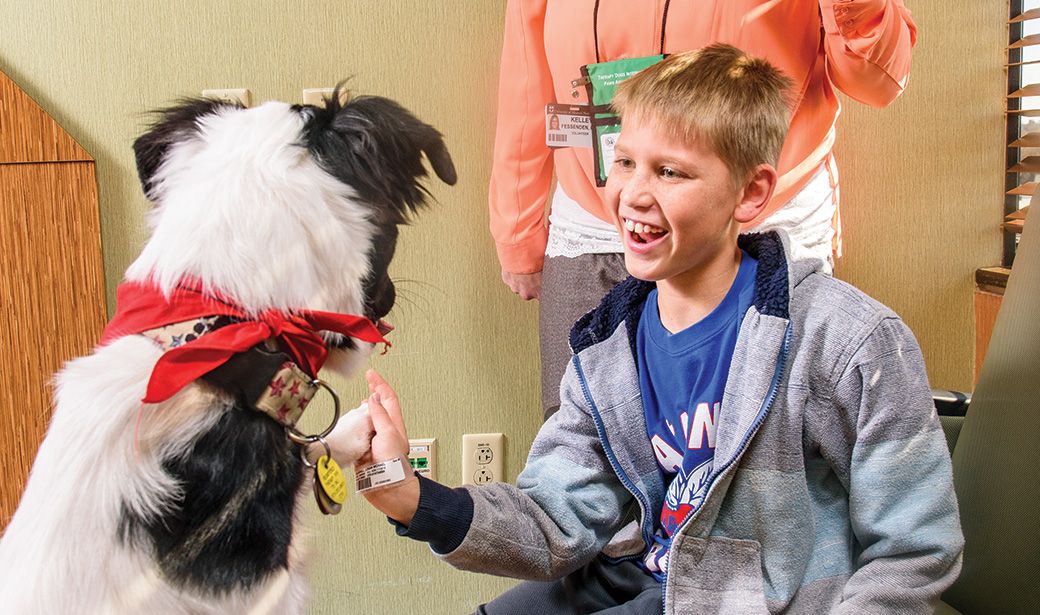When Kelley Fessenden and her husband adopted Trooper from the Sedalia Animal Shelter in 2017, she had big plans for a mixed-breed puppy whose life got off to a rough start. He arrived at the shelter with a broken right front leg that had to be amputated.
“Although some people feel sorry for Trooper and say he has a disability, my husband and I don’t see Trooper in that sense,” Fessenden said.
She thought her dog’s challenges could be an inspiration for patients. She took Trooper to obedience school, and he earned certification as a therapy dog. Now, he is a familiar furry face at MU Health Care’s Children’s Hospital. On a mid-November afternoon, he happily hobbled into the room of 10-year-old Logan Gladhill.
“I’ve never seen a dog in a hospital,” Logan said as he scratched Trooper behind the ears. “This is actually pretty cool.”
Studies have shown pet therapy in hospitals reduces blood pressure, lowers pain perception and improves patient experience scores in children and adults. Sarah Hicks, a business intelligence analyst for the Office of Patient Experience, coordinates MU Health Care’s therapy dog program. She also volunteers with Bean, a beagle-yorkie mix that Hicks adopted after finding her limping along the side of a road. Like Trooper, Bean gets around on three legs.
“It’s really amazing how much it impacts the patients,” Hicks said of dog visits. “I’ve heard many say, ‘You don’t know how badly I needed that visit.’ It provides them an outlet and some time to be human instead of just a patient.”
Therapy dogs come in all sizes, including Rocío Rivera’s 3-year-old chihuahua, Cosita — the name translates from Spanish as “little thing” — that brightens the days of patients at Ellis Fischel Cancer Center. To be eligible for the program, dogs must be at least 1 year old and pass a behavior test administered by an instructor certified by Therapy Dogs International or complete the MU College of Veterinary Medicine’s PALS program.
On the day of their visit, the dogs are bathed and have their nails trimmed. The unit they’re visiting provides a list of patients who don’t have infection or allergy concerns. A volunteer asks eligible patients if they would like a visit. If so, the patients sanitize their hands before and after petting the dog. A fresh sheet is placed over the bed if the dog is going to climb aboard.
Jessica Kerbs, a third-year student at the vet school, takes her 8-year-old standard poodle Zazu to visit University Hospital’s internal medicine patients a few times a month. She said Zazu gets excited and runs to the door every time she breaks out his blue volunteer bandana.
“I remember one patient who looked really sad and lonely when we walked into her room,” Kerbs said. “She was thrilled as Zazu crawled into bed with her and started nudging her for attention with his nose. The patient said, ‘This just means so much to me.’
“I don’t know what the patients have been going through, but a lot of times they have dogs at home that they are missing. It’s extremely worth it for me to take a little time out of my day to come here and brighten the patients’ day.”



